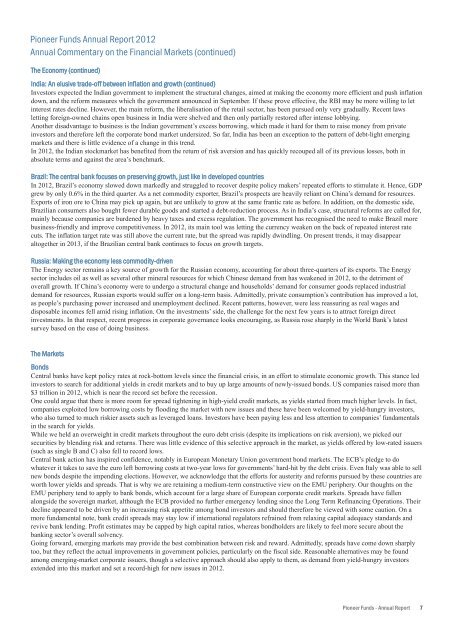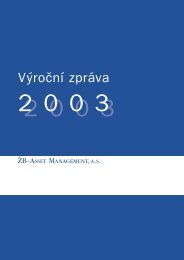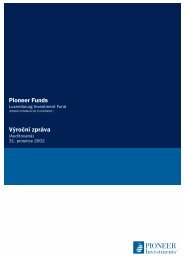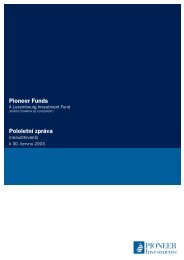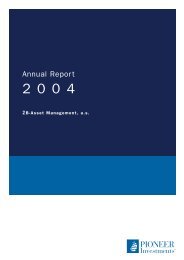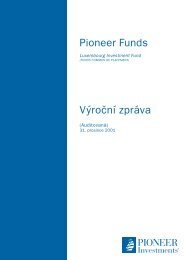Mise en page 1 - UniCredit Bank Slovakia as
Mise en page 1 - UniCredit Bank Slovakia as
Mise en page 1 - UniCredit Bank Slovakia as
You also want an ePaper? Increase the reach of your titles
YUMPU automatically turns print PDFs into web optimized ePapers that Google loves.
Pioneer Funds Annual Report 2012<br />
Annual Comm<strong>en</strong>tary on the Financial Markets (continued)<br />
The Economy (continued)<br />
India: An elusive trade-off betwe<strong>en</strong> inflation and growth (continued)<br />
Investors expected the Indian governm<strong>en</strong>t to implem<strong>en</strong>t the structural changes, aimed at making the economy more effici<strong>en</strong>t and push inflation<br />
down, and the reform me<strong>as</strong>ures which the governm<strong>en</strong>t announced in September. If these prove effective, the RBI may be more willing to let<br />
interest rates decline. However, the main reform, the liberalisation of the retail sector, h<strong>as</strong> be<strong>en</strong> pursued only very gradually. Rec<strong>en</strong>t laws<br />
letting foreign-owned chains op<strong>en</strong> business in India were shelved and th<strong>en</strong> only partially restored after int<strong>en</strong>se lobbying.<br />
Another disadvantage to business is the Indian governm<strong>en</strong>t’s excess borrowing, which made it hard for them to raise money from private<br />
investors and therefore left the corporate bond market undersized. So far, India h<strong>as</strong> be<strong>en</strong> an exception to the pattern of debt-light emerging<br />
markets and there is little evid<strong>en</strong>ce of a change in this tr<strong>en</strong>d.<br />
In 2012, the Indian stockmarket h<strong>as</strong> b<strong>en</strong>efited from the return of risk aversion and h<strong>as</strong> quickly recouped all of its previous losses, both in<br />
absolute terms and against the area’s b<strong>en</strong>chmark.<br />
Brazil: The c<strong>en</strong>tral bank focuses on preserving growth, just like in developed countries<br />
In 2012, Brazil’s economy slowed down markedly and struggled to recover despite policy makers’ repeated efforts to stimulate it. H<strong>en</strong>ce, GDP<br />
grew by only 0.6% in the third quarter. As a net commodity exporter, Brazil’s prospects are heavily reliant on China’s demand for resources.<br />
Exports of iron ore to China may pick up again, but are unlikely to grow at the same frantic rate <strong>as</strong> before. In addition, on the domestic side,<br />
Brazilian consumers also bought fewer durable goods and started a debt-reduction process. As in India’s c<strong>as</strong>e, structural reforms are called for,<br />
mainly because companies are burd<strong>en</strong>ed by heavy taxes and excess regulation. The governm<strong>en</strong>t h<strong>as</strong> recognised the need to make Brazil more<br />
business-fri<strong>en</strong>dly and improve competitiv<strong>en</strong>ess. In 2012, its main tool w<strong>as</strong> letting the curr<strong>en</strong>cy weak<strong>en</strong> on the back of repeated interest rate<br />
cuts. The inflation target rate w<strong>as</strong> still above the curr<strong>en</strong>t rate, but the spread w<strong>as</strong> rapidly dwindling. On pres<strong>en</strong>t tr<strong>en</strong>ds, it may disappear<br />
altogether in 2013, if the Brazilian c<strong>en</strong>tral bank continues to focus on growth targets.<br />
Russia: Making the economy less commodity-driv<strong>en</strong><br />
The Energy sector remains a key source of growth for the Russian economy, accounting for about three-quarters of its exports. The Energy<br />
sector includes oil <strong>as</strong> well <strong>as</strong> several other mineral resources for which Chinese demand from h<strong>as</strong> weak<strong>en</strong>ed in 2012, to the detrim<strong>en</strong>t of<br />
overall growth. If China’s economy were to undergo a structural change and households’ demand for consumer goods replaced industrial<br />
demand for resources, Russian exports would suffer on a long-term b<strong>as</strong>is. Admittedly, private consumption’s contribution h<strong>as</strong> improved a lot,<br />
<strong>as</strong> people’s purch<strong>as</strong>ing power incre<strong>as</strong>ed and unemploym<strong>en</strong>t declined. Rec<strong>en</strong>t patterns, however, were less re<strong>as</strong>suring <strong>as</strong> real wages and<br />
disposable incomes fell amid rising inflation. On the investm<strong>en</strong>ts’ side, the chall<strong>en</strong>ge for the next few years is to attract foreign direct<br />
investm<strong>en</strong>ts. In that respect, rec<strong>en</strong>t progress in corporate governance looks <strong>en</strong>couraging, <strong>as</strong> Russia rose sharply in the World <strong>Bank</strong>’s latest<br />
survey b<strong>as</strong>ed on the e<strong>as</strong>e of doing business.<br />
The Markets<br />
Bonds<br />
C<strong>en</strong>tral banks have kept policy rates at rock-bottom levels since the financial crisis, in an effort to stimulate economic growth. This stance led<br />
investors to search for additional yields in credit markets and to buy up large amounts of newly-issued bonds. US companies raised more than<br />
$3 trillion in 2012, which is near the record set before the recession.<br />
One could argue that there is more room for spread tight<strong>en</strong>ing in high-yield credit markets, <strong>as</strong> yields started from much higher levels. In fact,<br />
companies exploited low borrowing costs by flooding the market with new issues and these have be<strong>en</strong> welcomed by yield-hungry investors,<br />
who also turned to much riskier <strong>as</strong>sets such <strong>as</strong> leveraged loans. Investors have be<strong>en</strong> paying less and less att<strong>en</strong>tion to companies’ fundam<strong>en</strong>tals<br />
in the search for yields.<br />
While we held an overweight in credit markets throughout the euro debt crisis (despite its implications on risk aversion), we picked our<br />
securities by bl<strong>en</strong>ding risk and returns. There w<strong>as</strong> little evid<strong>en</strong>ce of this selective approach in the market, <strong>as</strong> yields offered by low-rated issuers<br />
(such <strong>as</strong> single B and C) also fell to record lows.<br />
C<strong>en</strong>tral bank action h<strong>as</strong> inspired confid<strong>en</strong>ce, notably in European Monetary Union governm<strong>en</strong>t bond markets. The ECB’s pledge to do<br />
whatever it takes to save the euro left borrowing costs at two-year lows for governm<strong>en</strong>ts’ hard-hit by the debt crisis. Ev<strong>en</strong> Italy w<strong>as</strong> able to sell<br />
new bonds despite the imp<strong>en</strong>ding elections. However, we acknowledge that the efforts for austerity and reforms pursued by these countries are<br />
worth lower yields and spreads. That is why we are retaining a medium-term constructive view on the EMU periphery. Our thoughts on the<br />
EMU periphery t<strong>en</strong>d to apply to bank bonds, which account for a large share of European corporate credit markets. Spreads have fall<strong>en</strong><br />
alongside the sovereign market, although the ECB provided no further emerg<strong>en</strong>cy l<strong>en</strong>ding since the Long Term Refinancing Operations. Their<br />
decline appeared to be driv<strong>en</strong> by an incre<strong>as</strong>ing risk appetite among bond investors and should therefore be viewed with some caution. On a<br />
more fundam<strong>en</strong>tal note, bank credit spreads may stay low if international regulators refrained from relaxing capital adequacy standards and<br />
revive bank l<strong>en</strong>ding. Profit estimates may be capped by high capital ratios, where<strong>as</strong> bondholders are likely to feel more secure about the<br />
banking sector’s overall solv<strong>en</strong>cy.<br />
Going forward, emerging markets may provide the best combination betwe<strong>en</strong> risk and reward. Admittedly, spreads have come down sharply<br />
too, but they reflect the actual improvem<strong>en</strong>ts in governm<strong>en</strong>t policies, particularly on the fiscal side. Re<strong>as</strong>onable alternatives may be found<br />
among emerging-market corporate issuers, though a selective approach should also apply to them, <strong>as</strong> demand from yield-hungry investors<br />
ext<strong>en</strong>ded into this market and set a record-high for new issues in 2012.<br />
Pioneer Funds - Annual Report 7


